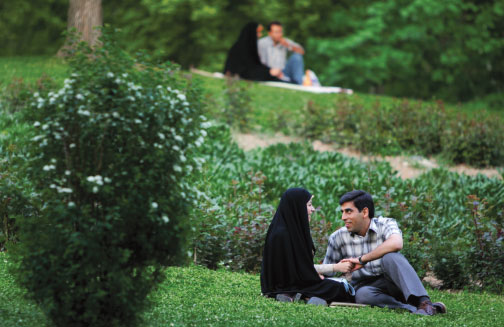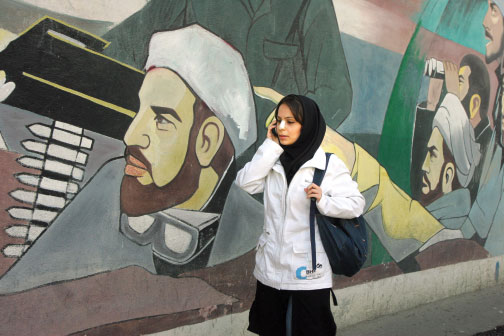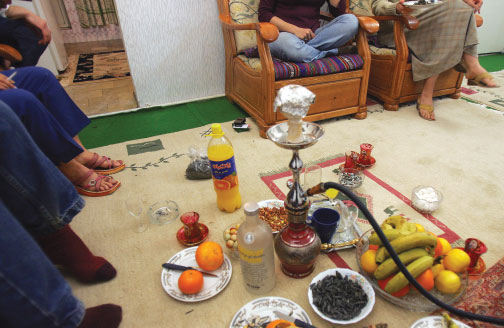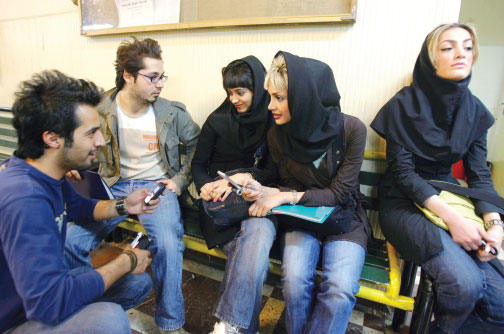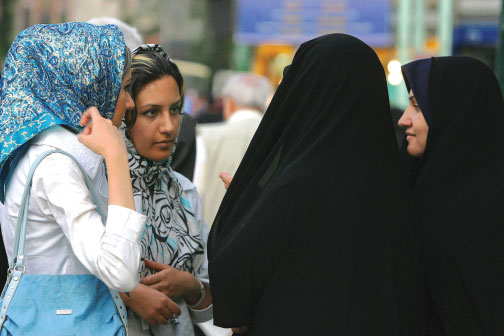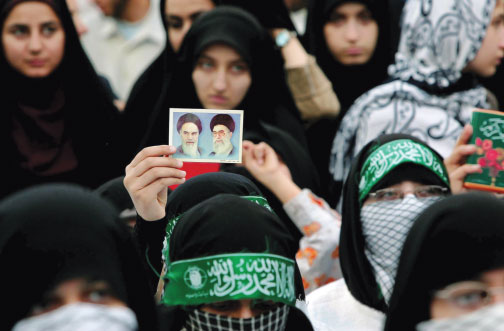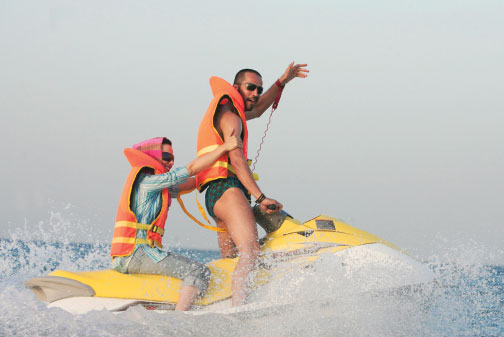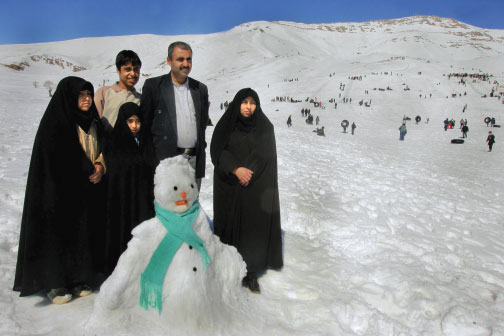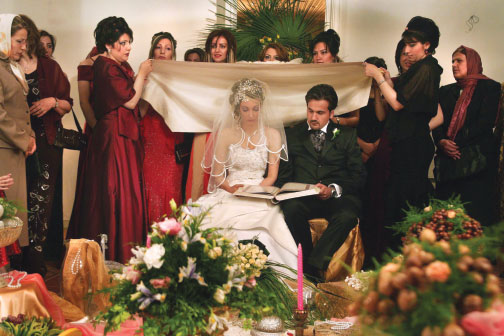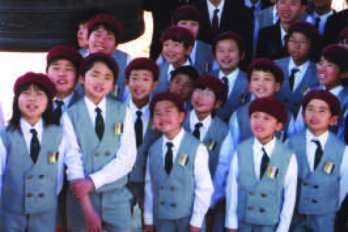The bus rumbled along a highway in southwest Iran, passing a series of anti-aircraft batteries and rickety guard towers before pulling in through a checkpoint to the Bushehr nuclear plant compound. Having anticipated significant difficulties finding, much less nearing, the reactor, I stared in stunned silence at its dome. So much for state secrets. It glistened like a mosque.
I sat in the women’s section at the back, mentally drafting the travel brochure: “Welcome to Bushehr! Take our budget bus tour of the facility that has everyone talking!” One could imagine the collective synaptic energy emanating from Washington, London, Paris, and Bonn, striking the gleaming white dome like flint sparks. Yet to my fellow travellers—locals being taken to their homes surrounding the plant, weary labourers half asleep in the men’s section, women in the brightly coloured layers traditional in the Persian Gulf—it was just an average day in a quiet Iranian fishing village where nothing much happens. They didn’t even look out the window.
We passed a sign that welcomed “Dear Guests” to the reactor’s information centre, but the bus tour was just as good: no security shakedown and all for less than a dime, round trip. Plus it ran past the ocean, providing a stellar view of the Persian Gulf and a lung full of sea air. What more could one ask of a nuclear power plant tour
So much has changed since the Bushehr reactor was launched in the early 1970s with the enthusiastic endorsement of the United States. Whether it will ever produce weapons-grade fissile material is open to question, but thirty years ago the Ford administration (at the urging of Westinghouse and other US companies, which stood to make billions as suppliers) agreed to sell the Shah of Iran a full nuclear fuel cycle, thereby providing all the ingredients necessary to make nuclear weapons. Then as now, Dick Cheney and Donald Rumsfeld held key national security portfolios and Paul Wolfowitz was in charge of stemming nuclear proliferation. According to Henry Kissinger, who was privy to the agreement, that subject never came up.
The deal dissolved after the 1979 Islamic revolution, when the uprising’s founder, Ayatollah Ruhollah Khomeini, deemed nuclear weapons “un-Islamic” and halted the program. For twenty-five years, the issue of Iran’s nuclear capabilities and ambitions was of no great concern. Today, they are deemed a threat to the West, while within Iran the pursuit of nuclear energy has become a powerful symbol of national identity.
On the other side of Bushehr, among the salt-encrusted fishing vessels, I chatted with a woman in her thirties, a pleasant-faced housewife in a flower-patterned chador. “Come to my home, “she said, leading me through a labyrinth of mud brick alleyways. The walls of her home were painted turquoise, the colour of the sea. Inside was her husband, an invalid, thin and drawn, unable to walk. He talked of the wounds he had sustained in the war with Iraq—a war that spanned the 1980s and claimed a million lives. Taking my hand, he pressed it into the missing flesh of his thigh. He had endured countless surgeries, but he and his wife were able to have a child—a delicate eight-year-old son, their greatest joy.
We sat on carpets drinking hot tea and eating oranges as a ceiling fan lazily nudged the sultry air. To be in an Iranian home is to enter a private garden where the problems of the outside world recede. So much of what the world knows about Iran is distorted, enslaved by the past or, in the present, by war-on-terrorism rhetoric. I wondered how this family would fare in the event of a military strike on their neighbourhood reactor. Would they so readily invite a foreigner home
Iran is a complex, even contradictory nation, and in the context of rising tensions and a growing threat of war, the lens through which the West and the Islamic republic view one another has become dangerously blurred. For the West, Iran is a nation of wild-eyed zealots shouting the familiar refrain of marg bar Amrika—death to America. It’s an image Iranian authorities have not hesitated to promote in their efforts to quell internal dissent and present the outside world with the image of a fearsome, loyal populace. Yet Iran has changed remarkably in the quarter century since the Islamic revolution, and such reductionist images are deceiving.
The war with Iraq was unsettling for many reasons, not least of which were American support for Iraq and weapons sales from the West that served to arm both sides. After a period of uneasy transition, the election of reformist president Mohammad Khatami in 1997 ushered in an era of social liberalization that proved to be transformative. Expats were lured back, satellite television and the Internet seized the popular imagination, and in Iran’s cities, at least, a repressive, closed society opened its doors. If current military threats have had little impact on the population, the juggernaut of Western cultural hegemony is an altogether different matter. Having adopted (or adapted) many of “our”ways, Iranians today know far more about the West than the West knows about them.
The mutual mistrust between the administrations of Iran and the US is illustrated by their reciprocal epithets: the Axis of Evil versus the Great Satan (or the “Global Arrogance,” as Iran’s leaders now refer to America). Among certain American politicians, there are mounting fears that the “mad mullahs” are on the verge of obtaining the bomb, potentially annihilating Israel (though of course this could annihilate the Palestinians in the process), and strengthening Iran’s role as a regional power. Meanwhile, Shia leaders with strong ties to Iran have risen to power in Iraq, a result that should have been anticipated but wasn’t. The Iranian government nonetheless sees itself surrounded by hostile forces: an American-occupied Afghanistan; a nuclear-armed Pakistan; and Iraq, a fractious nightmare where Americans forces are constructing permanent military bases and the world’s largest US embassy—reportedly the size of Vatican City. Iran’s leaders fear an aggressive Israel and its undeclared nuclear arsenal as well as America’s desire to see not only change, but regime change.
By acquiring nuclear technology, Tehran is asserting itself at the centre of an emerging locus of Shia power that includes Iraq and Lebanon and directly threatens US efforts to restructure the Middle East. Yet the sentiment surfacing from Tehran echoes that expressed by Defense Minister Mostafa Mohammad Najar: “The United States has been threatening Iran for twenty-seven years, and this is not new for us. Therefore, we are never afraid of US threats.”
At the centre of the bravado is new president Mahmoud Ahmadinejad. The former mayor of Tehran emerged from the generation who fought in the Iran-Iraq War. Americans may have forgotten their government’s support for Saddam Hussein in that eight-year conflict, but Ahmadinejad has not. A former Revolutionary Guards commando affiliated with the basij, the paramilitary defenders of the Islamic revolution who helped elect him, Ahmadinejad represents a hardline faction that opposes any rapprochement with the West. He and his followers are at odds with others in leadership positions—to say nothing of Iran’s upper classes—who see political and economic openness as the best way forward, but conflict with the West (and the international attention he is receiving) strengthens Ahmadinejad at their expense.
Within days of last summer’s presidential election, Iran forged ahead on its nuclear program. Emulating Ayatollah Khomeini, the new president laid everything on the line. Much had changed since 2003, when an apparently imminent American victory in Iraq persuaded Iran to offer a full peace deal to the US, a proposal American officials immediately rejected. It was, some now admit, a colossal mistake.
The US is currently mired in Iraq, and Iran, with the world’s third-largest oil reserves, has the capability to choke off the Strait of Hormuz, through which one-fifth of the world’s oil passes. It has strengthened its economic ties to Russia—a nation wary of US intentions in the region—and China, which recently inked its largest oil and gas deal in history with Iran. Any attack on the Islamic republic would be viewed by both nations as an attack on their national interests. It could also send oil prices into the stratosphere.
Iran’s chief nuclear negotiator, Ali Larijani, has rejected American demands that, in return for negotiations aimed at resolving the crisis over Iran’s nuclear activities, Iran suspend uranium enrichment and reprocessing—conditions that add up to forfeiting Iran’s main bargaining chip before even sitting down to the table. His country, Larijani insists, is acting within its rights in pursuing nuclear power but is willing to talk if plans for sanctions and regime change are set aside and security guarantees are proffered. The United States is determined to topple his government whether or not the crisis is resolved, he has said. “They want to set fire to the region.”
Lacking verifiable intelligence on any nuclear weapons program, and the experience of Iraq’s non-existent wmds still fresh in their minds, US civilian and military leaders are deeply divided over the next move. Vice President Dick Cheney and Defense Secretary Donald Rumsfeld have been leading the charge to war, reports the New Yorker’s Seymour Hersh, while many military leaders are cautioning against it.
Ahmadinejad, meanwhile, appears at ease amid the high-stakes diplomacy. The cards, he believes, are ultimately in Iran’s hand.
At bootleg dvd shops around the country, a film called The Crimes of Saddam is a bestseller, as is Uday Hussein’s home wedding video, a kitsch souvenir of how the mighty have fallen. Iranians are glad their arch-enemy Saddam Hussein has been ousted but they are well aware that it was in Iran, not Iraq, that the US embarked on its first Middle Eastern regime change. In 1953, the cia (with British involvement) overthrew Iran’s first democratically elected prime minister, Mohammad Mossadegh, after his parliament voted to nationalize Iran’s oil industry.
To find the Islamic republic’s “official” view of the United States, I visited the former US embassy in Tehran, now formally referred to as the Den of Spies. In 1979, a group of students loyal to Ayatollah Khomeini stormed the embassy and took its staff hostage. They claimed to have feared a reprisal of 1953, when the US reinstalled the Shah and trained his notorious secret police, whose repressive tactics led to the popular revolution. Inside the embassy is an exhibition called “American Democracy Fair.” Amid a phantasmagoria of satirical sculptures and caricature art pillorying US and Israeli foreign policy are rooms filled with antiquated James Bond—style equipment, relics from a previous era of US espionage. I passed by decoder devices, a soundproof meeting room, and document shredders. Hundreds of pages of shredded documents revealing American machinations have been meticulously reconstructed and sell on CD at the bookstore next door.
In the garden outside the embassy, the husk of a helicopter—from the failed US mission to rescue the fifty-two American hostages imprisoned here for 444 days—serves as an art installation, and the surrounding trees are adorned with signs that read “Down With USA.” Indeed, all of the signs seemed to be in English, which made sense when I realized that the only visitors are Western diplomats or journalists. Iranians clearly aren’t the target of this particular message. But do they agree with this view
My quest for an answer led me to another post-revolutionary attraction: the Shah’s summer palace at the foot of Tehran’s magnificent Alborz mountains. Set on manicured grounds replete with peacocks, the palace is crammed with overwrought Louis xiv—type furnishings, a 1970s take on Versailles. All that remains of the statue of the Shah is a pair of tall bronze boots—a monarchy cut off at the knees. By opening the palace to the public, Iranian authorities intended to expose the Shah’s extravagant lifestyle, entertaining the powerful while the people starved. Instead, it has become a pilgrimage site for young Iranians born after the revolution, who see not corruption and abuse of power but a symbol of their nation’s past glory.
Understanding the role and significance of Iranian youth is crucial to developing a complete picture of the forces now shaping Iran. After the revolution, birth control was sharply restricted. In the following decade, the population nearly doubled. Today, 70 percent of Iran’s seventy million citizens are under thirty, making it one of the world’s youngest nations.
Shortly before his death in 1989, Ayatollah Khomeini recognized the looming housing and employment shortages and reversed course. Iran has since become a model of family planning. It now operates the only government-approved condom factory in the Middle East, and a month’s supply of the pill is readily available without prescription for the price of a cup of tea. University students are required to take a sex-ed course in order to graduate, and couples must take contraception classes to receive a marriage licence. Most families now have no more than one or two children, even in the villages.
Ayatollah Khomeini had envisioned the baby boom as a twenty-million-member army of “soldiers for Islam,” but in Iran things rarely turn out as planned. Through sheer strength of numbers, the revolution’s children are pushing an agenda at odds with their elders. The new generation—a modern version of America’s postwar baby boom—is more interested in good times than guns, in ecstasy over Islam. At the royal palace, students and young couples snap pictures in the gardens and speak in hushed tones outside the gaudy palace chambers with their mirrored walls. They have no memory of the Shah’s rule by fear, no recollection of the savageries of the secret police, of the disappeared, the maimed, and the permanently silenced. Gazing at the photographs of world leaders that adorn the palace, they recall an era when Iran was a global player, a respected member of the community of nations. Reflecting on the 2,500-year history of the Persian Empire—a superpower that stretched from Anatolia and Egypt across western Asia to northern India and Central Asia—they envision a future in which Iran is no longer an international pariah. One man summed up the overriding sentiment: “We don’t want a wall around our country.”
Despite the murals of Ayatollahs Khomeini and Khamenei who watch, godlike, from the sides of high-rise buildings (alongside Calvin Klein and Nokia ads), most Iranians are busy doing their own thing. They are buying bootlegged booze, from fine French Cabernet Sauvignon at $20 (US) a bottle to the Tuborg beer and Absolut vodka that supplement readily available homemade arak. They are watching the latest Hollywood movies on dvd, smuggled in from Malaysia, or mtv, the bbc, and Fashion Television via satellite. They are holding dance parties with the blinds drawn and text-messaging their boyfriends and girlfriends. An underground sexual revolution is raging, and legal and cultural prohibitions on dating simply mean that young couples tend to meet in private. “When you meet in someone’s home, it’s all about sex,” a young man told me. A young woman, alluding to the oral sex that preserves their chastity, said coyly, “The girls here are very skillful.”For the wealthy, at least, lost virginities can be reclaimed by a trip to the surgeon.
“Where else in the world would you have your drugs, your booze, your rock ‘n’ roll delivered to your door This country is like a giant boarding school,”joked a former journalist who had left the profession after too many nights spent in prison for assisting foreign correspondents.
For embattled journalists and young Iranians, the Internet has become a source of unprecedented freedom. With at least seventy thousand active blogs, about half belonging to women, Farsi is the third most common blogging language in the world. Iran’s hardline judiciary, which has closed more than one hundred newspapers since 2000, hasn’t figured out how to cope with the Internet. Websites that are deemed “un-Islamic” (like the popular international dating site Orkut.com) are shut down or filtered, but alternative sites or workarounds arise just as quickly and word spreads.
Omid Memarian, a prominent journalist and blogger, is a handsome, clean-shaven young man who’s part of the new generation of Iranians that seldom part with their laptops. We met at Jaam-eJam International Food Court on Valiasr Street, the hippest hangout in Tehran. A replica of the shiny neon food courts found in any American shopping mall, it was the perfect setting to observe the generation gap. Sitting at a plastic table surrounded by sirens in tight jeans and form-fitting manteaus (the shirt-dresses urban women prefer to the chador) busy smoking cigarettes and reapplying lip gloss, I found it impossible to imagine that this giant boarding school might be on the brink of war.
In a culture where black is the colour of piety, and the hijab is required by law, women tested the outer limits in lime green and fuchsia. Despite restrictions on mixing with the opposite sex, they flirted provocatively with young men in goatees and longish hair, one of whom had an American flag patch sewn to the butt of his jeans. The occasional guy or girl showed off the fresh white bandage of a recent nose job, an obsession among the middle and upper classes.
“So much has changed that the generation born before the revolution can’t keep up,” observed Memarian. We spoke of the social freedoms that followed the Khatami presidency—from sweeping changes in women’s fashions to diminishing crackdowns on male-female relationships that once were grounds for arrest. Lashings have all but disappeared and unmarried couples now hold hands in public. “Everything used to be underground,” said Memarian. “Now you see it on the street.” He pointed toward two heavily made-up young women whose teased blond highlights made a mockery of their flimsy scarves. “The previous generation was idealistic, but the new generation is materialistic and self-involved. They don’t remember revolution and war. They aren’t interested in the ideals of the Islamic government.”
Memarian was among some twenty Internet journalists arrested in the fall of 2004. Though he had never publicly criticized the clerical establishment or the Supreme Leader Ayatollah Khamenei—the standard reason for running afoul of the authorities—he spent two months in prison enduring repeated interrogations and beatings. “I think the arrests were a political project,”he surmised, “to inspire fear.” While his prison experience still gives him nightmares, he laughed about the images of Jennifer Lopez that his interrogators took from his laptop. Since moral indiscretions are commonly used as grounds for imprisonment, he was questioned about the nature of his relationship with J.Lo.
Glancing at the hipsters crowding the food court, he noted a government study that identified four critical issues among Iranian youth: sex, unemployment, drugs, and waning religious devotion. Given the challenges they pose to Islamic rule, the government has been reluctant to address these issues publicly, but they are openly discussed on the Internet. Technology has provided Iranian youth with a voice that is increasingly difficult to silence. “The Internet shows how life in Iran is divided into two parts,”said Memarian, “the one the government tries to present, and the real society which wants to change the socio-political and economic situation and is always pushing the boundaries.”
Such change was the focus of my conversation with Iran’s most famous “blogging cleric,” Mohammad Ali Abtahi, a former vice-president under Khatami. At his office in Tehran, he spoke of the quiet revolution transforming Iran. “The speed of technology is accelerating social change,” Abtahi told me, after excusing himself to don his cleric’s robe and turban. The changes, he explained, are so vast and unprecedented that those in their teens are already a generation apart from their siblings a few years older. And the early adopters, he said, are the vanguard of society: “They are leading their whole families.”
This love affair with technology, however, is largely restricted to the urban middle and upper classes. Many Iranians I spoke to in rural villages had not even heard of the Internet. Indeed, there is a growing divide in Iranian society, not only between young and old but between urban and rural, modern and traditional, rich and poor. Even Tehran is split along class lines: Internet use and access to the outside world are clearly the purview of the wealthier, more cosmopolitan northern half of the city. It was this divide that determined the presidential election.
The news that underdog candidate Mahmoud Ahmadinejad had won last June’s election by a landslide shocked both foreign observers and Iranian analysts, who had predicted an easy victory for his main competitor, billionaire cleric and former president Ali Akbar Hashemi Rafsanjani. The evening after the election, I went to Tajrish Square, where the crowd was affluent and surprisingly festive. Plastic palm trees loomed up against the night sky, glowing electric yellow and orange. Elaborate fruit stands displayed large glass jars in which peeled walnuts floated in brine, like miniature brains. A group of fashionably dressed young people were checking out a selection of Hollywood movies at one of the stands. I asked a young woman with a pierced lip if she’d voted for Mahmoud Ahmadinejad. She laughed in my face. “Who”she said, walking away with her arm around her boyfriend.
Like the girl with the pierced lip, most of the middle and upper classes were unfamiliar with Ahmadinejad, a scruffily bearded blacksmith’s son who had run on a platform of economic justice. His campaign film showed him in his modest home, illustrating that he—like the masses of poor and working class—sat on the floor to eat in the traditional manner rather than adopting the dining table habits of Westernized elites. When an interviewer asked him if he had a summer home, he laughed, a pointed jab at establishment corruption.
In the midst of a campaign characterized by flash and cash, Ahmadinejad identified himself as a humble “street sweeper,” a man not so different from those who voted for him. He represented conservative Shia values: in his tenure as mayor he’d introduced separate elevators for men and women in his offices; and in the park outside Tehran’s central theatre where gay men were known to congregate, he had threatened to build a mosque.
Rafsanjani, in contrast, had run on a platform of ever-increasing social liberalization that played well to the wealthy minority. His campaign operatics included sexy girls in tight manteaus who rode on rollerblades with pro-Rafsanjani bumper stickers wrapped around their waists. I attended an open-air Persian rock concert at his Tehran headquarters, where the female emcee kissed her husband on stage to ecstatic applause. Everyone—that is, everyone in north Tehran, everyone with money—was sure Rafsanjani had the presidency in the bag. Unfortunately for him, a reputation for corruption and a general apathy among his natural constituents undermined his electoral chances. Many of the middle and upper class did not vote on principle, as if to do so would only support a governing system they despised. Disillusioned with Khatami, whose liberal initiatives were all too frequently quashed by unelected clerics, they believed the president’s office was too weak to usher in genuine change.
A few even hoped Ahmadinejad would win: a hardline victory, they told me, would expose the harshness of Iranian authorities and so enrage the masses that they would overturn the government. They were the ones most likely to watch satellite broadcasts from Los Angeles made by exiled supporters of the former Shah and his ambitious son, Reza Pahlavi, who would like nothing more than a return to power and has urged the Bush administration to attack Iran. Though eager for a piece of the $75 million the US State Department has requested to fund anti-regime broadcasting, Pahlavi has virtually no support base in a nation weary of bloodshed and war. “People don’t want another revolution,” said Khosrow Hassanzadeh, a prominent artist who was a teenager in 1979, echoing the widespread sentiment. “Revolution is horrible. It breaks everything.”
While the other candidates emphasized high-minded notions like democracy and human rights or expounded on social liberalization, Ahmadinejad galvanized millions with promises of fighting corruption and redistributing Iran’s oil wealth. To the poor and unemployed (officially 14 percent of the population, but likely twice that), his platform resonated. “No one thinks of human rights when they need bread,” said one savvy twenty-two-year-old female blogger, analyzing the failures of the reform movement (which couldn’t even garner enough votes to move their candidates into the second round of elections).
Ahmadinejad was the only candidate who didn’t allude to closer relations with the West. Furthermore, though pious, he is not a cleric, a fact that played to his advantage. Corruption was the word I most often heard Iranians associate with the clerics, who are seen to have enriched themselves while failing to deliver on the revolution’s promise of social justice for the poor and oppressed—a venerated class in Shia Islam. I will never forget watching a cleric clutch his flowing robes as he ran across a busy street in a working-class borough, the cars accelerating as they attempted to run him down.
To understand Ahmadinejad’s supporters, one must leave the bubble of north Tehran, with its laptops and nose jobs and pizza parlours. In south Tehran, I befriended a young woman whose father was a toy wholesaler, a member of the powerful conservative class of bazaari merchants who had been the muscle behind the Islamic revolution. Massoumeh greeted me at the door in an orange sundress. At twenty-four, she is a graduate student in engineering—not unusual given that 63 percent of Iranian university students are now women. She told me she liked Ahmadinejad, admired the fact that he lived in a humble manner, drove an old car (a clunky Iranian-made Paykan), and spoke the language of her concerns: fighting corruption, creating jobs, and loaning young people the money to marry—a grave social problem among the poor—with his proposed billion-dollar Love Fund. “He is a good Muslim man,”she said approvingly.
A social conservative who always wears a chador outside her home—and together with her ten-year-old sister ran to don it when their brother-in-law arrived to join us—she distrusted the social freedoms promoted by other candidates. To her, such changes had gone far enough already. When I mentioned the young women from Rafsanjani’s campaign reportedly dancing in the streets, her dark eyes narrowed with disdain. “Those candidates didn’t understand that we have freedom. Other problems are more important.”
While most north Tehranis have all but stamped out the dying coals of the revolution, Massoumeh’s family represents the traditional religious class, which remains devoted to its aims. They are committed to the principles of Shia Islam and seek both fundamental justice and non-materialist family values. It is this deep vein that Ahmadinejad has tapped. “Imam Khomeini,”Massoumeh said, referring to the revolution’s founder, “is like a father to us.”
Her real father, an imposing man with the four-days-growth beard of the religious, wanted to know my opinion on Iran’s pursuit of nuclear energy. Since the election, state television had been broadcasting regular programs on the marvels of the atom. (They reminded me of American propaganda films from the 1950s.) “If the rest of the world can have nuclear power, why not Iran”the father asked. He could not understand how it was that Israel, India—even an unstable military regime like Pakistan—could have nuclear weapons, yet Iran should be criticized for pursuing nuclear energy. Though much is made of Iran’s enormous oil and gas reserves, calling into question their need for nuclear energy, a woeful lack of refining capacity means the country currently spends $2 billion (US) a year on gasoline imports.
To this family—as to most Iranians I spoke to, religious, secular, rich, and poor— Iran has been singled out. Their view is underscored by the fact that, unlike Iran, those other nations have refused to sign the Nuclear Non-Proliferation Treaty, which would subject them to inspections by the International Atomic Energy Agency (iaea)—and which allows member nations to develop civilian nuclear power.
While Iranians are divided on almost every other level, here is one issue on which they can agree: it is a double standard. “Iran, “the father said solemnly, one large hand on each knee, “is as good as any other country.”
If American officials are under the impression that Iran’s pro-democracy opposition will make common cause with any sort of military intervention, they might talk to Dr. Sohrab Razzaghi, a professor of political science and director of the Iranian Civil Society Organizations Training and Research Center. His organization works to strengthen Iran’s nascent civil society and publishes research on the state of Iranian democracy. “Iranian civil society,”he told me, “is paper thin.”
At his office, piled with books and reports, he described Iran as being in a “transformative period—“neither fully democratic nor fully undemocratic, neither fully modern nor fully traditional, neither fully religious nor fully secular. In such moments of “fear and hope”outcomes are uncertain, he said. Already, American threats have led ngos like his, with ties to the international community, to be labelled “agents of imperialism.”Like the broad majority of opposition voices in Iran, Razzaghi is opposed to outside force, insisting that removing a strong central power without adequate democratic institutions in place will have dire consequences. “Iran is a multi-ethnic society, so there are two tendencies when the central power is weakened: one is a disintegration into tribal groups and the other is violence.”American threats serve the current political system and weaken the opposition, Razzaghi believes.
As water boiled for tea, he continued. “I’m not so optimistic about the future of things we hear regarding American threats and plans for a “Greater Middle East.’ You can look at history and the interference of the US in Iran fifty years ago, which caused the Islamic revolution twenty-five years later. We don’t know how American actions will affect the future, but I don’t think they will bring democracy to Iranians in the long term.”
Nor does Shirin Ebadi, a human rights lawyer and the most powerful woman in Iran. In 2003, she was awarded the Nobel Peace Prize, becoming Iran’s first-ever Nobel laureate and the only Muslim woman to receive the honour. At her office in Tehran, she wielded a letter opener like a sabre as she described the human rights issues for which she has endured arrest and imprisonment. While she vocally opposes many of her government’s actions, she is even more vocal in her opposition to regime change and military intervention. Change, she believes, must be internally generated, as has been the case in parts of the former Soviet Union, such as Kazakhstan.
“I never believe in foreign pressure,”she told me, her hair protruding from beneath a white scarf. “I believe in Iranian public opinion. Look at Iraq and look at Kazakhstan. In Iraq it was foreign pressure and in Kazakhstan it was people pressure, from the bottom up. How much have they hurt Iraq Yet with no casualties, the people in Kazakhstan won.”
Without oil, Iran would have neither the money nor the wherewithal to develop nuclear energy, much less the bomb. Here, oil is seen as the reason the US overthrew the Mossadegh government half a century ago. And as the world approaches peak oil—the point at which half of the world’s reserves have been depleted, making each successive barrel harder and more expensive to extract—oil and the atom have become the yin and yang of global energy politics.
In the oil-rich city of Ahwaz, near the border with Iraq, the night sky blazes with towering gas flares and daytime temperatures surpass 50°c. In the air-conditioned lobby of the Fars Hotel, scores of oil workers from Asia, Europe, and South America gather after work to eat ice cream and drink icy glasses of Delster, a popular non-alcoholic beer. I spoke with an Iranian oil engineer who has been working in the region since before the revolution. His views displayed a quintessential Iranian pragmatism.
He missed the Americans, he told me, and spoke fondly of his colleagues from Halliburton, the Texas-based company he said had been working there until 2004 when US authorities discovered it was violating trade sanctions. “They’ll be back,”he assured me. Shaking a cigarette from a pack of Winstons, he said, “In Iran, we want to do business but we don’t want to be under anybody’s flag. Even me. I don’t want to be under anybody’s flag. But we can be partners. We can do business. And,”he said, leaning close to my face, “we will do business.”
On my return to North America, I flew American Airlines through Chicago. Settling in to watch the in-flight entertainment, I was taken aback by the steady stream of religious programming so reminiscent of Iranian state television. First came a half-hour special about a doctor who combines “medicine and ministry”by convincing geriatrics they can make love well into their sunset years. Next was a saccharine movie about a pastor’s daughter who asked God to help her make friends in a new town (her prayers were answered), followed by an episode of Touched by an Angel.
It occurred to me that as a soft theocracy takes hold in America, the differences between the US and Iran have become less striking. Since the election of Ahmadinejad, power has shifted to a group of hardline Iranian neo-conservatives, so named for their US counterparts, who advocate a similar cocktail of religion, nationalism, and militarism. Like Bush, Ahmadinejad portrays himself as a regular guy, someone you’d have over for kebab and soft drinks (both men are teetotalers). Like Bush, he knows the value of the photo op, posing for the cameras as he kicked around a soccer ball with Iran’s World Cup team. And like Bush, he speaks the language of down-home faith and family values dear to religious conservatives…and the language of bellicosity to “the enemy.”As Iranian human rights activist Emad Baghi told the Washington Post, “I feel Ahmadinejad and President Bush are like two blades of a scissor.”
Unlike Bush, however, Ahmadinejad has pursued a populist economic agenda, using state oil revenues to address the most pressing needs of the poor and working class, devoting billions to schools, raising the minimum wage, and lowering lending rates. His anti-corruption policies have further strengthened his popularity, and fears that he would restrict social liberties have failed to materialize. Even many of the most skeptical, the middle and upper classes, have been won over.
Nonetheless, in an ominous replay of the case against Iraq, the US administration is sounding the alarm that Iran is seeking nuclear weapons. Bush is pushing for swift action from the UN Security Council; failing this, he has indicated he may act unilaterally. The most recent US National Security Strategy document reaffirms the policy of pre-emptive first strikes against rogue nations, stating, “We may face no greater challenge from a single country than from Iran.”
While Iran’s leadership is far from agreeable, it is not insane. By calling for an end to the “Zionist regime,”Ahmadinejad is presenting himself as a disciple of Ayatollah Khomeini, whose speeches he has taken to quoting. Internationally, his diatribes are an attempt to vie for leadership within the Sunni-dominated Muslim world. Domestically, he aspires to show himself as more revolutionary (i.e., more patriotic) than opponents like archrival Rafsanjani, who continues to be influential. With marginal (though not inconsequential) military resources, Iran’s leadership well knows that Israel would handily defeat them in any engagement, likely in a matter of hours. Yet by asserting himself on the regional and international stage—while simultaneously deploying populist economic policies—Ahmadinejad is emerging as a national hero.
The iaea has yet to find any evidence of an Iranian nuclear weapons program, and even if Iran’s nuclear ambitions include acquiring the bomb, US intelligence suggests that such an achievement is likely ten years away. Fears of an imminent crisis therefore appear exaggerated. But when the US agrees to assist India in its civil nuclear program despite that country’s nuclear weapons, when it avoids confronting Pakistan or Israel on their nuclear arsenals, and when the Pentagon is devising next-generation nukes of its own, it is not difficult for Ahmadinejad to depict the US as both the “Global Arrogance”and a nuclear provocateur. As favourably disposed to the US as many Iranians are—partly due to their infatuation with American cultural products and an authentic desire for the expanded freedoms the US has publicly advocated—they have rallied around Iran’s pursuit of nuclear power as a symbol of national pride.
In the event that the US (or Israel) takes aggressive action, Iran will not be a passive player. It has hinted that it may engage allies in other, highly volatile areas, such as Lebanon, Palestine, and Iraq, and has indicated it will restrict oil exports, potentially shutting down the Strait of Hormuz. Shia leaders in Iraq, who have thus far resisted calling for the withdrawal of US troops, are likely to turn on the Americans, making a bad situation incalculably worse. And what of casualties A 2006 report published by the Oxford Research Group estimates that initial deaths in Iran from an American or Israeli strike would measure in the thousands, given that Iran’s nuclear facilities are dispersed in urban areas. “The new reactor nearing completion at Bushehr would be targeted, although this could be problematic once the reactor is fully fuelled and goes critical some time in 2006,” the report notes. “Once that has happened, any destruction of the containment structure could lead to serious problems of radioactive dispersal affecting not just the Iranian Gulf coast, but west Gulf seaboards in Kuwait, Saudi Arabia, Bahrain, Qatar, and the United Arab Emirates.”
While advocates of the military option argue that the population will spontaneously rise up against their government if only given a “push,” the opposite response is far more probable. Iranians are staunchly nationalistic. Any outside aggression will likely cause them to unite behind a leadership that is otherwise gradually being forced to confront mounting “people pressure”for reform and engagement with the world. For Shirin Ebadi and other pro-democracy dissidents, military action against Iran threatens to roll back the hard-won gains of recent years: change, they argue, must come from within, and the West should be engaging in constructive diplomacy, not threats of war.
Iran is a land of contradictions, and it’s hard to imagine any country in the world where a Westerner would enjoy a more gracious welcome. To be in a shared taxi in any part of Iran is to have your sleeve plucked by someone who says, as an opening gambit, “I would die for you” (a standard greeting in the poetics of Farsi etiquette). And then: “Come to my home.” In my six-month journey from the mountains of Kurdistan in the northwest to the bazaars of Kerman in the east to the oil regions on the border with Iraq, it is impossible to catalogue how many meals and accommodations were offered by strangers of a half-hour’s acquaintance.
And as often as I attempted to interview them, they turned the tables: What do they know of us in the West Do they think we are all terrorists
What could I tell them in return?
